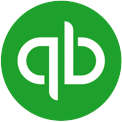Do you own a wholesale business? If so, then knowing your ROI is a critical step to success. In this post, we're going to teach you everything you need to know about ROI: why it is essential, and how to calculate it for your wholesale business.

Calculating ROI for Your Wholesale Business: A How-To Guide
What is ROI and Why Is It Important?
First, let's start with the basics. What does ROI stand for? It stands for return on investment. It measures the performance of monetary investments and, ultimately, is an indicator of the effectiveness of your spending.
Why knowing your ROI is critical
If you can calculate the ROI for the things you invest in — new equipment, advertising strategies, employee hiring, small business loans — you will know if they were worthwhile. You can use these as predictors to decide if similar future investments would be a good move for your business.
How to Calculate ROI: A ROI Formula for Your Wholesale Business
So how do you calculate ROI for your wholesale business? The most straightforward ROI formula, according to most sources, is as follows:

Calculating ROI Example #1
Since this is typically a formula used by investors, let's use an investing example.
You bought shares for a company five years ago for $1,000, and they are now worth $5,000. Your ROI is ([$5,000 - $1,000] ÷ $1,000) x 100, or 400%.
Calculating ROI Example #2
Now, let's think about the ROI of your products. You make tie-dye t-shirts. You have to purchase basic white t-shirts, paints, and other supplies. You then have to create wholesale prices for your t-shirts that cover your costs, create a profit, and stay competitive so your buyers can mark the prices up to retail.
This is where knowing how to calculate ROI comes into play. You know how much your supplies cost, plus you have to add in packing and shipping costs. You know how much of a profit you want to make. And you know how much your customers (retailers) are going to sell them for. You can also use the Wholesale Price Calculator below if you need help nailing down your wholesale price.
Your cost per shirt is $4. You determine the wholesale price per shirt is $6, giving you a wholesale margin of $2. Now, let's say you get an order for 100 shirts. Your ROI is ([$600 - $400] / $400) x 100, or 50%.
What is a Good ROI for a Wholesale Business
If you have an ROI of 50% from a $600 that gives you a $200 profit, that's a solid ROI. But something that isn't factored into the formula above is time. It is not only the time spent creating your products, but if you don't have an inventory and order management system in place, the time spent processing the order.
According to a TradeGecko survey, "businesses under $1M spend over 90 hours on inventory management, product sourcing, and managing orders every month".
Every minute you spend on low-dollar, administrative tasks is one minute less you have to spend on revenue-driving tasks like nurturing leads, closing sales, and growing your wholesale business.
Every minute you spend on low-dollar, administrative tasks is one minute less you have to spend on revenue-driving tasks like nurturing leads, closing sales, and growing your wholesale business.
The ROI of Investing in Wholesale eCommerce Platforms
Finding a B2B eCommerce platform for your wholesale business isn't as difficult as it may seem. And it can make the most of one of your most valuable resources: time. Shopify offers all of the features, apps, and integrations you need to sell wholesale and sync your data with major retailers.
Or, if you're looking to start an online store with best-in-class inventory management and supply chain capabilities, you might opt for TradeGecko's native B2B eCommerce platform.
How do you calculate the ROI of investing in a platform like Shopify or TradeGecko?
This one's a bit more complicated. In addition to the price of the software itself, you need to also account for things like:
- Employee training
- Maintenance and technical support
- Data migration
- Cybersecurity and other add-ons
But software more often than not saves you a sizable chunk of time, in turn saving you money, which can more than justify the investment. Here's a scenario to help illustrate this.
Let's say you have a team of five. You pay each employee $25 an hour. Together, your team spends about 90 hours per month on inventory and order management. That adds up to a whopping $27,000 a year. Woah.
So, you decide that it's time to invest in a platform that streamlines inventory and order management. You sign up for TradeGecko's Small Business Plan at $199 per month, which translates to a total of $2,388 per year.
But, let's say this investment cuts the amount of time your employees spend per month on inventory and order management in half, reducing it to 45 hours per month. You're saving $13,500 per year.
The ROI on investing in TradeGecko's platform for the first year would be 465%.
ROI = ([$13,500 - $2,388] / $2,388 ) x 100
And that's not all — you have to consider the opportunity cost. These are the opportunities that your team cannot take advantage of due to the 90 hours a month they spend on inventory and order management.
Now, consider the extra 45 hours a month that your team will have to spend on these opportunities, many of which could directly impact your bottom line.
Investing in software automates (and eliminates) time-intensive operational tasks, streamlining your operations and saving you precious hours and money in the process.
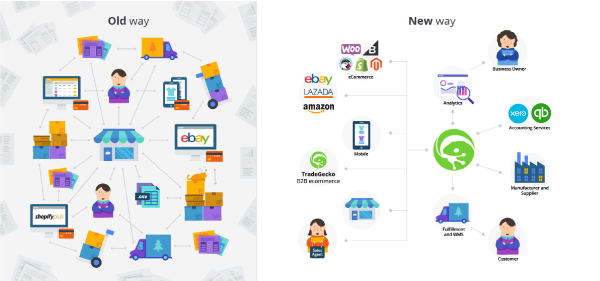
Bonus: Learn how Pilot Coffee Roasters was able to save two to three hours per day on data entry with TradeGecko.
The ROI of Marketing
Now, let's look at one last reason why it's essential to know your ROI inside and out.
Calculating the ROI of your marketing can significantly impact where you choose to invest your marketing efforts and budget.

What you will need is an eCommerce platform for selling your products (like Shopify or TradeGecko) and website analytics (like Google Analytics). Combined, when used correctly, they will give you the actual ROI of your marketing and advertising campaigns. Here's how.
First, you have to install Google Analytics on your eCommerce website. Most platforms have directions on how to do this. You will need to set up Google Analytics as well as set up conversions and eCommerce reporting.
Once you start collecting data, use your Acquisitions reports to see which traffic sources are sending website visitors that buy your products. For example, the Channels report will give you an overview of your search, social, and email marketing performance.
The Social Conversions report will give you a breakdown of performance per social network. It allows you to decide if your efforts on a particular social network were worthwhile.
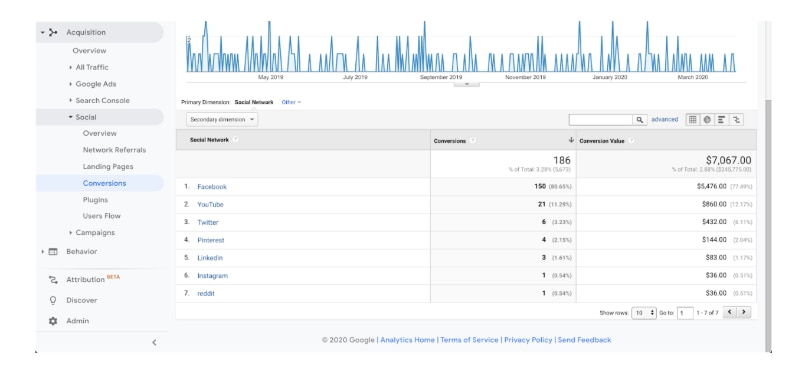
You can also create custom campaigns using UTM parameters via Google's URL builder. This page explains how you can track specific marketing and advertising campaigns, such as a spring sale, using parameters at the end of the URLs you share.
For example, if you have a spring sale on your t-shirts, you would create the following URL to promote the sale's landing page in a Facebook ad.
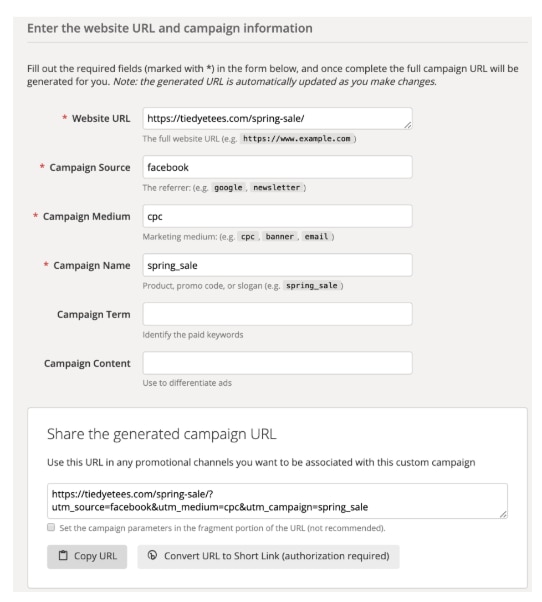
You would continue to create unique UTM parameters for the URLs you use in the rest of your paid and organic promotions, such as:
- ads on Instagram
- organic Facebook posts
- organic Pinterest posts
- organic Twitter posts
- paid Google search ads
- paid display ads
Once Google Analytics receives data from your campaign, you can review the specific traffic sources that drive visitors who buy to your wholesale business. You can use this data for your summer sales promotion, focusing your budget and time on the paid and organic traffic sources that ultimately drove the most conversions (sales) and highest ROI.
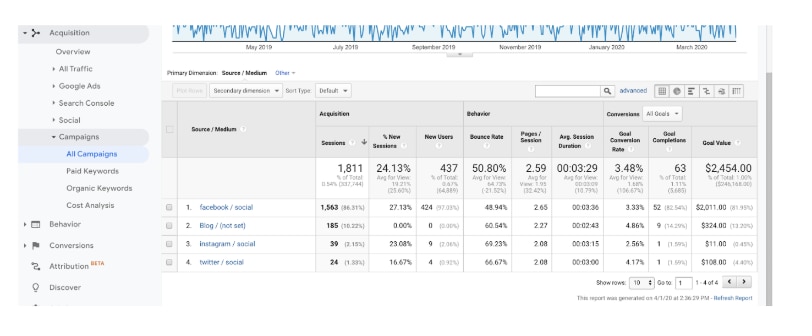
You can also use TradeGecko’s handy eCommerce Digital Marketing Model to measure the effectiveness of your different channels.
Note that the data used throughout the post is sample data. It should not be used as a basis for determining ROI for your business's marketing and advertising.
Conclusion
As you can see, knowing how to calculate ROI can be a gamechanger for your wholesale business. If your wholesale business isn't online, run the numbers for yourself. Calculate your current ROI and use a business loan calculator to see the total cost of the loan, and if it's worth it to use financing to invest in an eCommerce platform, build your online presence, and increase your sales.
Guest Contributor: Samantha Novick is a senior editor at Funding Circle, specializing in small business financing. She has a bachelor’s degree from the Gallatin School of Individualized Study at New York University. Prior to Funding Circle, Samantha was a community manager at Marcus by Goldman Sachs. Her work has been featured in a number of top small business resource sites and publications.








